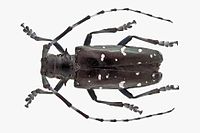
Photo from wikipedia
Human‐assisted movement has allowed the Asian longhorned beetle (ALB, Anoplophora glabripennis (Motschulsky)) to spread beyond its native range and become a globally regulated invasive pest. Within its native range of… Click to show full abstract
Human‐assisted movement has allowed the Asian longhorned beetle (ALB, Anoplophora glabripennis (Motschulsky)) to spread beyond its native range and become a globally regulated invasive pest. Within its native range of China and the Korean peninsula, human‐mediated dispersal has also caused cryptic translocation of insects, resulting in population structure complexity. Previous studies used genetic methods to detangle this complexity but were unable to clearly delimit native populations which is needed to develop downstream biosurveillance tools. We used genome‐wide markers to define historical population structure in native ALB populations and contemporary movement between regions. We used genotyping‐by‐sequencing to generate 6102 single‐nucleotide polymorphisms (SNPs) and amplicon sequencing to genotype 53 microsatellites. In total, we genotyped 712 individuals from ALB’s native distribution. We observed six distinct population clusters among native ALB populations, with a clear delineation between northern and southern groups. Most of the individuals from South Korea were distinct from populations in China. Our results also indicate historical divergence among populations and suggest limited large‐scale admixture, but we did identify a restricted number of cases of contemporary movement between regions. We identified SNPs under selection and describe a clinal allele frequency pattern in a missense variant associated with glycerol kinase, an important enzyme in the utilization of an insect cryoprotectant. We further demonstrate that small numbers of SNPs can assign individuals to geographic regions with high probability, paving the way for novel ALB biosurveillance tools.
Journal Title: Evolutionary Applications
Year Published: 2022
Link to full text (if available)
Share on Social Media: Sign Up to like & get
recommendations!